Concrete, Washington
| Concrete | |
|---|---|
| Town | |
| Concrete, Washington | |
|
Welcome sign chainsaw-carved from cedar logs greets visitors to Concrete, Washington | |
 Location of Concrete, Washington | |
| Coordinates: 48°32′21″N 121°44′50″W / 48.53917°N 121.74722°WCoordinates: 48°32′21″N 121°44′50″W / 48.53917°N 121.74722°W | |
| Country | United States |
| State | Washington |
| County | Skagit |
| Area[1] | |
| • Total | 1.24 sq mi (3.21 km2) |
| • Land | 1.22 sq mi (3.16 km2) |
| • Water | 0.02 sq mi (0.05 km2) |
| Elevation | 276 ft (84 m) |
| Population (2010)[2] | |
| • Total | 705 |
| • Estimate (2015)[3] | 716 |
| • Density | 577.9/sq mi (223.1/km2) |
| Time zone | Pacific (PST) (UTC−8) |
| • Summer (DST) | PDT (UTC−7) |
| ZIP code | 98237 |
| Area code(s) | 360 |
| FIPS code | 53-14380[4] |
| GNIS feature ID | 1518004[5] |
| Highways |
|
| Website | Town of Concrete |
Concrete is a town in north-central Skagit County, Washington, United States. The population was 732 at the 2010 census. The town of Concrete is included in the Mount Vernon-Anacortes, Washington Metropolitan Statistical Area.
Early history

The town of Concrete has undergone several incarnations, the earliest being a settlement at the northwestern junction of the Baker and Skagit Rivers, known as "Minnehaha." Amasa "Peg-Leg" Everett was one of the earliest settlers and in 1890, the townsite was platted by another settler, Magnus Miller. Shortly thereafter, a post office was established and the town name changed to "Baker." In 1905, a settlement across the Baker River came into being due to the building of the Washington Portland Cement Company and was named "Cement City." After the Superior Portland Cement Company plant was built in Baker in 1908, it was decided to merge the two towns. Inhabitants of the new community settled on the name "Concrete" and the town was so christened and officially incorporated on May 8, 1909.[6]
Notable buildings and landmarks
The town of Concrete is home to many old and original buildings, as well as a couple of engineering milestones:[7]
Henry Thompson Bridge
%2C_02.jpg)
Built in 1916–1918 and so named for the Scottish immigrant, local settler, and Skagit County Commissioner who promoted its construction. The naming occurred after Henry Thompson was killed by a logging train in 1918.[8] At the time, its graceful arch was the longest single-span reinforced concrete bridge in the world[9] or perhaps just in the West[8] and has been listed on the Washington State and National Historic Register since 1976.[10] Until 1972, when the Washington State Department of Transportation re-routed Highway 20 (then known as Star Route 20) outside the town, the Thompson Bridge was the only connecting thoroughfare across the Baker River and into eastern Skagit County.
The bridge was originally designed by Bowerman and McCloy Consulting Engineers of Seattle, and built by J.R. Wood Contractors also of Seattle.[8] It underwent a complete rehabilitation in 2003-2004. The engineer for the rehabilitation was Entranco, Inc. of Bellevue, Washington (who has since been acquired by AECOM) and the contractor for the rehabilitation was One Way Construction of Sedro-Woolley, Washington.
Concrete High School
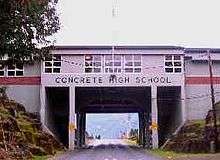
Concrete High School[11] was built in 1952. Constructed with the typical and necessary scholastic appointments and one visible and unusual difference: the central portion of the building was built over the road leading to it. To make the best use of the property, South Superior Avenue passes beneath the building, providing a weather-protected school bus loading zone. The building replaced the previous high school building in the center of town. The hallways and the wood shop were used during the filming of the Michael Caton-Jones film, This Boy's Life in 1992. Concrete High School's school colors are purple and gold and their team mascot is the Lion. CHS's sports teams participate in the Northwest 2B/1A league under the Washington Interscholastic Activities Association. Concrete's Future Business Leaders of America was the fastest growing in the state during the 2012-13 school year.[12]
Mt. Baker Presbyterian Church
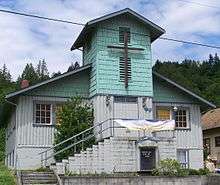
Built in 1908 with a log-hewn outer structure. The church's first minister, Reverend L.C. Michaels did most of the carpentry work and assisted in bringing the logs for the construction down from the surrounding hills on horseback. Originally built for a capacity of 310, the full-basement houses a kitchen, restrooms, and meeting area. The building has been since remodeled and some of the original log-structure no longer visible. Rev. Paul E. Toms served as pastor of the church in the 1940s.
Concrete Herald building
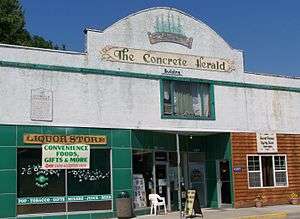
Located in the heart of Concrete Town Center on Main Street, the Concrete Herald Building was originally built in 1918 as a Model T Ford garage complete with a gas-station out front. When the building was later converted to be the Brommer Logging facility, a large apartment was added to the upper story. It was shortly after this that Concrete Herald owner and editor Charles M. “Chuck” Dwelley took over the building and made it into a modern printing facility and new home of The Concrete Herald (established in 1910). When Robert and June Fader purchased the newspaper upon Dwelley's retirement in late 1970, the building remained the home for the weekly. When the building and newspaper were sold in 1990, the facility became a printing shop until the current owners turned the first floor into a liquor store franchise through the state liquor control board. The Concrete Herald Building has remained a liquor store to this date. As for Concrete Herald, Concrete Mayor Jason Miller has given rebirth to the newspaper after purchasing the Upriver Community News from another local resident. As of May 6, 2009, Concrete Herald began a monthly publication schedule. The newspaper is sold in various locations throughout Skagit County.[13]
Town Hall

Originally built in 1908 as a grade-school, this wooden, clapboard building was originally located on Main Street across from the bank where classes were taught until 1910. When the building was no longer used as a schoolhouse, it was moved to its present location on West Main Street, next to the current post office. In its present location, the building has served alternately as a library, senior-citizen center, the city's current town hall with a satellite office for the Skagit County Sheriff's Department.
Shepherd of the Hills Lutheran Church

Built in 1909, the town's Lutheran church hasn't always been a church. The beginnings of this historic building were as a hospital in the "Cement City" area east of the Baker River. Built by Dr. E.F. Mertz, the doctor and his wife lived in the second-story residence and maintained the hospital facility on the first floor. Dr. Mertz was the only doctor in central through eastern Skagit County for many years as well as for both the town's cement plants. In 1929 the hospital was remodeled to be a grand mansion complete with hardwood oak flooring, mahogany woodwork, imported mural and flock wallpaper, crystal light fixtures and hot water heat radiators in each room. The mansion was then furnished with antique and custom-built furniture and soon became a show place where the Mertzes entertained both local and distant visitors. When both the doctor and his wife had died by 1945, the home, property, and contents was put up for auction and purchased for only $13,500 – well below the 1929 renovation price of $40,000. The purchaser, Concrete Herald newspaper owner and editor Charles Dwelley, sold the home and property in 1953 to the Evangelical Lutheran Church. The ELC then did extensive remodeling, adding a wing on the east room which would house the sanctuary. The new church was dedicated on Sunday, March 7, 1954 and is still in use by the incorporated Evangelical Lutheran Church in America.
Concrete Assembly of God
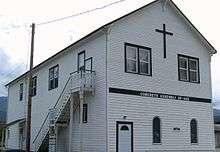
Built in 1910, the two-story building was originally a one-story structure housing an Odd Fellows Lodge in the back room with the front of the building rented out to several merchants, including a popular grocery store. When the second story was built for a larger lodge hall it was modernized to contain a kitchen and indoor restrooms. As Odd Fellows membership dropped significantly in the 1950s, the building was taken over by the Odd Fellows auxiliary Rebekahs Lodge until the 1970s. After that, the main and upper floors of the building were rented out to various businesses over the years, including a local-history museum, antique shop, and the local Eagles Lodge. After remaining empty for a number of years, the building became the Concrete Assembly of God church sometime in the 1990s. The church's congregation has since remodeled and restored the building.

St. Catherine's Catholic Church
Built in 1912 by the Catholics of the community, this picturesque building is located on a hillside overlooking the town. The parish maintains a newer C.C.D. center across the street built in 1964.
Concrete Theatre
Originally built in 1923, the stage of the Concrete Theatre has entertained audiences with vaudeville, boxing matches, silent films and later what were known as "the talkies". The building is listed on the Washington Heritage Register [14] and is reportedly home to a few "other-worldly spirits" alleged to visit on a regular basis. Recently sold to local business owners, they remodeled the theatre and once again opened it in February 2010. The new owners show old as well as recent-run films and host live performances. They also allow many community events take place such as Youth Dynamic nights and church choir recitals. More history of the theatre, as well as current information, can be found here.[15]
Lower Baker Dam

At the time Lower Baker Dam was completed in 1925 and two years later raised to 293 feet (89 m), it was the highest hydroelectric dam in the world. It is currently owned, operated, and maintained by Puget Sound Energy.
Community Bible Church
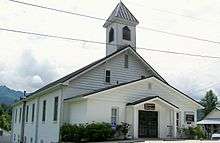
Built in the mid-1950s, this non-denominational church was erected directly behind the current Mt. Baker Presbyterian Church as the result of a "church-split" by members of the local Presbyterian congregation. While some Presbyterian members felt more drawn to Baptist theology, others were steadfast in their Presbyterian theology. The resolution came when a large number of members left the Mt. Baker Presbyterian Church to build their own, non-denominational church with funds raised to establish their presence elsewhere. Reverend Guy Morris was the original pastor; the Community Bible Church remains the newest church-sanctuary building in the town of Concrete.
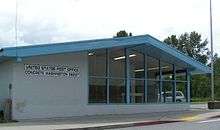
Post office
Built in 1960, the Hoover Building currently houses Concrete's post office. Originally Hoover's Food Center, it was then owned and operated by Concrete resident Hargus Hoover and his sons. The United States Postal Service purchased the building in the early 1970s, where it has been located since.
Notable locals
Concrete has had its share of interesting characters—some famous, and some only locally known.
Lady entrepreneurs and telephone pioneers[16]
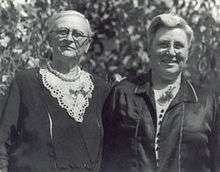
Two such locally known and enterprising females decided that they would help bring Concrete into the 20th Century in a before-their-time fashion.
Sisters Kate Quackenbush Glover and Nell Quackenbush Wheelock were born in Clay, New York in 1866 and 1877, respectively.[17] They both arrived in Skagit County in 1908 and shortly thereafter, Kate was hired by the Superior Portland Cement Company to manage their telephone exchange. Initially, Kate lived at the exchange building until the phone company became incorporated. Investing her wages over time, Kate was able to purchase controlling interest in the company, renaming the telephone system, "Skagit River Telephone Company". Kate and her younger sister Nell bought the existing telephone exchange building from Portland Cement as well – remodeling it to house the phone system on the entire lower level. After building an outside stairway to the upper level, Kate had the second floor converted to rooms they could rent, charging 50 cents a night.
Set on expanding their phone service to the areas east and west of Concrete, Nell climbed the poles and strung the lines. By 1918, the upriver phone lines extended to Hamilton and connected the Skagit River Telephone Company to the national phone system through Sedro-Woolley. The large logging camps and all government operations such as the local ranger stations and fish hatcheries had lines installed and served by the sisters' phone operation. Nell was also in charge of the work crew that dug and set all the company poles. She had a team of horses she drove to drag the poles into position, directing the pole setting, and she would then finish the job by installing the telephone wiring.
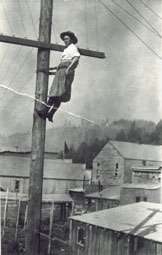
Kate was in charge of the switchboard operation (with the assistance of a young girl they had taken in, Ethel Thompson). The phone service was equipped with hand-crank-style phones that would ring into the switchboard by a live operator and the telephone service these women gave was quick and often personal. In the event that no one answered the line being rung by the operator, Kate or Ethel would often promise to find them as soon as possible and have the call returned. When there was a problem with a line down, or a phone not operating properly, Nell would rush to service the problem.
Beyond their telephone enterprise, the Quakenbush sisters were known in Skagit County for their ability to do almost anything they put their minds to. As a trained nurse, Kate sometimes assisted in childbirth as a midwife. Additionally, when she first arrived in the county from the east-coast, Kate worked on the homestead she shared with her then-husband (and later Concrete City Marshal), Joe Glover, helping to "prove up" on their timber claim on the upper Baker River, near Bear Creek. Together, Kate and Nell claimed the vacant lot between their home and their telephone office and built a chicken house – raising thousands of chickens and selling the eggs as well as some of the chickens. Nell and Kate also purchased a large tugboat in order to tow logs to a lumbermill on Lake Shannon and operated a fishing-boat franchise. Building a large float on Lake Shannon (just above the town of Concrete), they had approximately fifty fishing boats available for rent. Nell ran the tugboat for the mill operation and Kate ran the fishing boat operation on the weekends, allowing them to still run the telephone company during the week.

With modern progress and some personal hardships came change for Kate and Nell's businesses. In July 1935, due to faulty business-dealings and technological modernization, the sisters were forced to sell their communication enterprise to the Skagit Valley Telephone company (later known as Continental Telephone) with service based out of Mount Vernon, Washington – 30 miles (48 km) "downriver". To add insult to injury, the bookkeeper the sisters had hired and trusted with Power of Attorney and managing their finances was discovered to have been embezzling funds for quite some time. The bookkeeper was tried and sent to prison, but irreversible damage had been done to the company's finances as the greater portion of the company's bank account had been stolen, forcing Kate and Nell to sell. Following the sale of the telephone company, the sisters moved to an unimproved property near Birdsview, building a small house for themselves along with a barn and chicken houses. Later, with their chicken houses having burned from an electrical short, their debt increased from a lack of fire insurance. Then, having been in poor health since the 1930s, Kate died on November 21, 1944 at the age of 78, deeply in debt.[18] Still suffering from her own mounting debts, Nell now was left with the burden of Kate's debts as well. In order to help pay off their combined debt, Nell bought an old tractor and worked wherever she could and long into her elderly years. Nell stayed in Skagit County up to her death in April 1969 at the age of 93.[19]
Tobias Wolff and This Boy's Life
Another local notable is internationally known author Tobias Wolff, who spent a large part of his teenage years in the Concrete area. Wolff's memoir This Boy's Life chronicles his early life living in eastern Skagit County and attending Concrete High School (referred to as "Chinook High School" in the novel). In 1993, the novel was also turned into a feature film (of the same name) starring Leonardo DiCaprio, Robert De Niro, and Ellen Barkin. The movie's exterior and outdoor scenes of Concrete (as well as some interior scenes) were filmed in the town of Concrete and the surrounding area and a number of local residents were used as extras. In order to fit the "look" of 1950s-era Concrete, the town itself was transformed back in time "Hollywood style" for the weeks that filming took place in 1992.
Notable happenings
State Bank of Concrete robbery
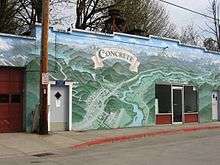
On April 16, 1931, during the height of the Great Depression, the locally owned and operated State Bank of Concrete was robbed at gunpoint and its employees taken hostage. Two men entered the bank during operating hours brandishing guns and taking $4,491.00 in cash from the bank's vault. After the money had been obtained, the two men then forced bank president George Campbell, bank clerk Ada Seabury, and bank customer George Harper into a car with them and sped away. When town residents spotted loose dollar bills in front of the bank on Main Street and noticed that there was no one inside the bank, town marshal Charlie Bagnell was notified. After a quick investigation, Bagnell contacted "downriver" law enforcement by telephone about the robbery and missing bank employees. The three kidnapped hostages were subsequently released by their captors at an area approximately four miles west of town on the highway known as the "rock-cut" and were soon after picked up by a passing motorist. The three gave descriptions of the criminals to Bagnell, who relayed the information to the county sheriff.
A road-block was set up downriver and west of Concrete by the sheriff's department. While driving the side roads off the highway looking for the bandits, searchers came across a fresh set of tire skid marks on what is today known as Cape Horn Road in Birdsview, a small farming community six miles west of Concrete. Following the tire tracks over a steep embankment, the searchers came to a deep eddy on the Skagit River, where the getaway car was discovered. Detectives from the sheriff's department concluded that the bank robbers had a boat ready to take them down the Skagit River, where they were able to escape completely.
Reportedly, many years later an outdoor writer named Ralph Young hired an Alaska bear-hunting guide on Kodiak Island who told a tale of being one of two bandits who robbed the State Bank of Concrete of $4700.00 in small bills on "April 1, 1930". The guide went on to say that he had lost the entire amount during "a crooked dice game" in Seattle only a few days after the heist. It is unknown if the Alaskan guide's story was true or what became of the bank-robbers.[20]
Orson Welles' War of the Worlds radio broadcast
On October 30, 1938, Seattle's CBS affiliate radio stations KIRO and KVI broadcast Orson Welles' now-famous War of the Worlds radio drama. While this broadcast was heard around the country, some of the most terrified listeners were in Concrete.[21]
At the point of the drama where the Martian invaders were invading towns and the countryside with flashes of light and poison gases, a power failure suddenly plunged almost the entire town of 1,000 into darkness. Some listeners fainted while others grabbed their families to head up into the mountains. Other more enterprising locals headed for the surrounding hills to guard their moonshine stills. One man was said to have jumped up out of his chair and, in bare feet, run the two miles (3 km) from his home to the center of town. Some of the men grabbed their guns, and one businessman – a devout Catholic – got his wife into the family car, drove to the nearest service station and demanded gasoline. Without paying the attendant, he rushed off to Bellingham (some forty-miles away) in order to see his priest for a last-minute absolution of sins. The distraught man reportedly told the gas-station attendant that paying for the gas "[wouldn't] make any difference, everyone is going to die!".
Because the phone lines (as well the electricity) were out, the town's residents were unable to call neighbors, family, or friends to verify that their fears were legitimate. Of course, the real story was not as fantastic as the fictional radio drama – all that had occurred was that the Superior Portland cement company's electrical sub-station suffered a short-circuit with a flash of brilliant light, and all the town's lights went dark. The more conservative radio-listeners in Concrete (who had been listening to The Chase and Sanborn Hour on another station) attempted to calm neighbors, reporting that they hadn't heard a thing about any "disaster". Reporters heard soon after of the coincidental blackout of Concrete, and sent the story out over the international newswire and soon the town of Concrete was known (if only for a moment) worldwide.[22]
Historic Concrete grade school destroyed by fire
On April 27, 2008 at approximately 1:45 p.m., the historic Concrete grade school building was reported to be on fire and according to fire officials, was fully engulfed in flames within twenty minutes. Despite the efforts of five fire departments (including Concrete, Burlington, Sedro-Woolley and two rural fire districts), the building was a total loss. Not able to enter the intensely heated building, the firefighters could only contain the fire within the concrete exterior walls in order to keep it from spreading to the adjacent buildings and trees.
After investigation by the ATF, Skagit County Fire Marshall and the Skagit County Sheriff's office, officials determined that arson was the cause of the blaze. According to the Skagit County Sheriff's Department in a press release, three pre-teen boys admitted during an interview that they had been playing with lighters and set a mattress left inside the building on fire. The boys maintained that they believed the fire they started had been extinguished before exiting the building.[23]
The 20-year owner of the property had initially intended to remodel the exterior of the building with a castle motif. This plan, however, was abandoned sometime in the 1990s, and the property sat uninhabited and the remodel incomplete for an extended period. In the years before the fire destroyed the landmark, the building had become known to out-of-towners and locals alike as an eyesore. Since the fire, the building has been slated for complete demolition. As of August 4, 2009, the long-awaited demolition of the buildings damaged by the fire began under the direction of Lautenbach Industries.
Local events
Annually, Concrete celebrates the seasons with a number of festivals.[24]
January
- Skagit Eagle Festival[24] – The beginning of the new year brings the Skagit Eagle Festival,[24] which attracts visitors from all over the country to see the largest convergence of bald eagles in the contiguous United States. The month-long festival features an interpretive center, photography workshops, musical entertainment, lectures, and Native American performances. Sponsored by the Concrete Chamber of Commerce.[24]
February - March
- Mardi Gras – The town is the site of an annual Mardi Gras celebration, including a "sun or snow" parade, kids' events and adult party.
- Lion's Club Annual St. Patrick's Day Dinner – Also commemorating St. Patrick's Day is the annual Lion's Club corned beef dinner held annually in the Concrete High School commons.
July
- The Cement City Street Fair is held each July, including a motorcycle rally and show. This event is held in conjunction with the Annual Fly-In at the Concrete Airport.
- The Annual Concrete Fly-In brings pilots, enthusiasts, and small aircraft to Concrete Municipal Airport. Homemade, antique, and various other small aircraft are on display along with food vendors and souvenir booths. Frequently, helicopter and airplane rides over the Skagit River with spectacular views of Mount Baker and the North Cascade mountains are available for a fee.
August
- Cascade Days is a summer weekend celebration that offers live music, a parade, fire-fighter and logging contests, bed races, a chili cook-off, and historic-town tours. Cascade Days is held annually the third weekend of August. More up-to-date information can be found at the Cascade Days official website.[25]
October
- Ghost Walk – For several weekends each October, the Concrete Chamber of Commerce and the Concrete Heritage Museum team up to present the Concrete Ghost Walk – a tour that features the spirited history and unusual characters who inhabited the area in its heyday (and some not so long ago).
- Fall Color Festival/Taste & Tour – Another annual event sponsored by the Concrete Chamber of Commerce, the festival is a celebration of the incredible colors of the area's fall leaves as well as a tasting tour of the local wineries and micro-breweries found along the "Magic 30-Miles" between Sedro-Woolley and Marblemount. Those participating annually are the Birdsview Brewing Co.,[26] Challenger Ridge Winery,[27] Eagle Haven Winery,[28] and Glacier Peak Winery.[29]
Geography
According to the United States Census Bureau, the town has a total area of 1.24 square miles (3.21 km2), of which, 1.22 square miles (3.16 km2) is land and 0.02 square miles (0.05 km2) is water.[1]
The town lies mostly on the north bank of the Skagit River, and is split into half by the lower Baker River (a tributary to the Skagit River). Mount Baker, a stratovolcano, lies northwest of Concrete and Mount Shuksan lies almost directly north. Both peaks are part of the North Cascades range.
Demographics
| Historical population | |||
|---|---|---|---|
| Census | Pop. | %± | |
| 1910 | 945 | — | |
| 1920 | 924 | −2.2% | |
| 1930 | 736 | −20.3% | |
| 1940 | 859 | 16.7% | |
| 1950 | 760 | −11.5% | |
| 1960 | 840 | 10.5% | |
| 1970 | 573 | −31.8% | |
| 1980 | 592 | 3.3% | |
| 1990 | 735 | 24.2% | |
| 2000 | 790 | 7.5% | |
| 2010 | 705 | −10.8% | |
| Est. 2015 | 716 | [30] | 1.6% |
| U.S. Decennial Census[31] 2015 Estimate[3] | |||
2010 census
As of the census[2] of 2010, there were 705 people, 295 households, and 179 families residing in the town. The population density was 577.9 inhabitants per square mile (223.1/km2). There were 358 housing units at an average density of 293.4 per square mile (113.3/km2). The racial makeup of the town was 91.5% White, 0.3% African American, 2.0% Native American, 0.4% Asian, 1.1% Pacific Islander, 1.6% from other races, and 3.1% from two or more races. Hispanic or Latino of any race were 5.5% of the population.
There were 295 households of which 31.5% had children under the age of 18 living with them, 42.0% were married couples living together, 12.2% had a female householder with no husband present, 6.4% had a male householder with no wife present, and 39.3% were non-families. 29.2% of all households were made up of individuals and 9.2% had someone living alone who was 65 years of age or older. The average household size was 2.39 and the average family size was 2.93.
The median age in the town was 40.4 years. 26.2% of residents were under the age of 18; 6.4% were between the ages of 18 and 24; 22.4% were from 25 to 44; 32.9% were from 45 to 64; and 12.1% were 65 years of age or older. The gender makeup of the town was 51.2% male and 48.8% female.
2000 census
As of the census[4] of 2000, there were 790 people, 300 households, and 198 families residing in the town. The population density was 650.3 people per square mile (252.1/km²). There were 335 housing units at an average density of 275.8 per square mile (106.9/km²). The racial makeup of the town was 92.78% White, 2.53% Native American, 0.89% Asian, 1.14% from other races, and 2.66% from two or more races. Hispanic or Latino of any race were 2.66% of the population.
There were 300 households out of which 37.0% had children under the age of 18 living with them, 45.3% were married couples living together, 14.3% had a female householder with no husband present, and 33.7% were non-families. 27.7% of all households were made up of individuals and 11.7% had someone living alone who was 65 years of age or older. The average household size was 2.63 and the average family size was 3.19.
In the town the population was spread out with 34.1% under the age of 18, 5.4% from 18 to 24, 28.6% from 25 to 44, 20.8% from 45 to 64, and 11.1% who were 65 years of age or older. The median age was 33 years. For every 100 females there were 97.0 males. For every 100 females age 18 and over, there were 100.4 males.
The median income for a household in the town was $29,375, and the median income for a family was $34,464. Males had a median income of $34,083 versus $17,083 for females. The per capita income for the town was $12,492. About 8.4% of families and 14.0% of the population were below the poverty line, including 15.4% of those under age 18 and 8.8% of those age 65 or over.
References
- 1 2 "US Gazetteer files 2010". United States Census Bureau. Archived from the original on 2012-01-24. Retrieved 2012-12-19.
- 1 2 "American FactFinder". United States Census Bureau. Retrieved 2012-12-19.
- 1 2 "Population Estimates". United States Census Bureau. Retrieved July 12, 2016.
- 1 2 "American FactFinder". United States Census Bureau. Archived from the original on 2013-09-11. Retrieved 2008-01-31.
- ↑ "US Board on Geographic Names". United States Geological Survey. 2007-10-25. Retrieved 2008-01-31.
- ↑ "Skagit Settlers: Trials and Triumphs, 1890–1920", Published by Skagit County Historical Society, 1975
- ↑ All information on these buildings and landmarks have been referenced from the local history book, "So They Called The Town Concrete," written by Charles M. Dwelley, published by The Concrete Herald, 1980; reprint 2004, 2009. It contains reputable knowledge of Concrete.
- 1 2 3 "Baker River Bridge HAER No. WA-105" (PDF). memory.loc.gov. August 1993. Retrieved 2013-04-03.
- ↑ The Concrete Herald, October 16, 1968
- ↑ Archived July 23, 2011, at the Wayback Machine.
- ↑ "High School". Concrete.k12.wa.us. Retrieved 2013-02-15.
- ↑ Shelton-Jenck, Gordon (January 28, 2013). "MEMBERSHIP GROWTH!". FBLA Newsletter.
- ↑ "concrete-herald.com". concrete-herald.com. Retrieved 2013-02-15.
- ↑ Archived July 27, 2011, at the Wayback Machine.
- ↑ Concrete Theatre
- ↑ "The Quackenbush sisters at The Stump Ranch Online". Stumpranchonline.com. Retrieved 2013-02-15.
- ↑ 1880 U.S. Census record for town of Clay, Onondaga County, New York – District 165
- ↑ Washington Death Index, 1940–1996
- ↑ Social Security Death Index
- ↑ "So They Called The Town Concrete", written by Charles M. Dwelley, published by The Concrete Herald, 1980; reprint 2004, 2009
- ↑ Stein, Alan J. (October 24, 2002). "Radio broadcast of War of the Worlds panics Seattle and the nation on October 30, 1938". HistoryLink.org.
- ↑ Bill Virgi (2003-10-22). "Radio Beat: Oct. 30, 1938 – The broadcast that scared a nation". Seattlepi.com. Retrieved 2013-02-15.
- ↑ Associated Press; 08:35 AM PDT on Wednesday, April 30, 2008
- 1 2 3 4 concrete-wa.com
- ↑ "cascadedays.com". cascadedays.com. Retrieved 2013-02-15.
- ↑ "birdsviewbrewingco.com". birdsviewbrewingco.com. Retrieved 2013-02-15.
- ↑ "challengerridge.com". challengerridge.com. Retrieved 2013-02-15.
- ↑ "eaglehavenwinery.com". eaglehavenwinery.com. Retrieved 2013-02-15.
- ↑ "glacierpeakwinery.com". glacierpeakwinery.com. Retrieved 2013-02-15.
- ↑ "Annual Estimates of the Resident Population for Incorporated Places: April 1, 2010 to July 1, 2015". Retrieved July 2, 2016.
- ↑ United States Census Bureau. "Census of Population and Housing". Archived from the original on May 11, 2015. Retrieved August 31, 2014.
External links
| Wikimedia Commons has media related to Concrete, Washington. |

